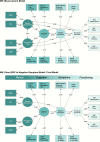Hierarchical Pathways from Sensory Processing to Cognitive, Clinical, and Functional Impairments in Schizophrenia
- PMID: 32856089
- PMCID: PMC7965084
- DOI: 10.1093/schbul/sbaa116
Hierarchical Pathways from Sensory Processing to Cognitive, Clinical, and Functional Impairments in Schizophrenia
Abstract
Cognitive impairment is a hallmark of schizophrenia and a robust predictor of functional outcomes. Impairments are found in all phases of the illness and are only moderately attenuated by currently approved therapeutics. Neurophysiological indices of sensory discrimination (ie, mismatch negativity (MMN) and P3a amplitudes) and gamma-band auditory steady-state response (ASSR; power and phase locking) are translational biomarkers widely used in the development of novel therapeutics for neuropsychiatric disorders. It is unclear whether laboratory-based EEG measures add explanatory power to well-established models that use only cognitive, clinical, and functional outcome measures. Moreover, it is unclear if measures of sensory discrimination and gamma-band ASSR uniquely contribute to putative causal pathways linking sensory discrimination, neurocognition, negative symptoms, and functional outcomes in schizophrenia. To answer these questions, hierarchical associations among sensory processing, neurocognition, clinical symptoms, and functional outcomes were assessed via structural equation modeling in a large sample of schizophrenia patients (n = 695) and healthy comparison subjects (n = 503). The results showed that the neurophysiologic indices of sensory discrimination and gamma-band ASSR both significantly contribute to and yield unique hierarchical, "bottom-up" effects on neurocognition, symptoms, and functioning. Measures of sensory discrimination showed direct effects on neurocognition and negative symptoms, while gamma-band ASSR had a direct effect on neurocognition in patients. Continued investigation of the neural mechanisms underlying abnormal networks of MMN/P3a and gamma-band ASSR is needed to clarify the pathophysiology of schizophrenia and the development of novel therapeutic interventions.
Keywords: cognitive function; functional outcomes; gamma-band auditory steady-state response (ASSR); mismatch negativity (MMN); schizophrenia.
© The Author(s) 2020. Published by Oxford University Press on behalf of the Maryland Psychiatric Research Center. All rights reserved. For permissions, please email: journals.permissions@oup.com.
Figures




Similar articles
-
Unique contributions of sensory discrimination and gamma synchronization deficits to cognitive, clinical, and psychosocial functional impairments in schizophrenia.Schizophr Res. 2021 Feb;228:280-287. doi: 10.1016/j.schres.2020.12.042. Epub 2021 Jan 22. Schizophr Res. 2021. PMID: 33493776
-
Test-retest reliability of mismatch negativity and gamma-band auditory steady-state response in patients with schizophrenia.Schizophr Res. 2022 Feb;240:165-174. doi: 10.1016/j.schres.2021.12.042. Epub 2022 Jan 11. Schizophr Res. 2022. PMID: 35030446
-
Source decomposition of the frontocentral auditory steady-state gamma band response in schizophrenia patients and healthy subjects.Psychiatry Clin Neurosci. 2021 May;75(5):172-179. doi: 10.1111/pcn.13201. Epub 2021 Feb 13. Psychiatry Clin Neurosci. 2021. PMID: 33470494
-
Gamma-Band Auditory Steady-State Response as a Neurophysiological Marker for Excitation and Inhibition Balance: A Review for Understanding Schizophrenia and Other Neuropsychiatric Disorders.Clin EEG Neurosci. 2020 Jul;51(4):234-243. doi: 10.1177/1550059419868872. Epub 2019 Aug 12. Clin EEG Neurosci. 2020. PMID: 31402699 Review.
-
A Meta-analytic Review of Auditory Event-Related Potential Components as Endophenotypes for Schizophrenia: Perspectives From First-Degree Relatives.Schizophr Bull. 2016 Nov;42(6):1504-1516. doi: 10.1093/schbul/sbw047. Epub 2016 May 23. Schizophr Bull. 2016. PMID: 27217271 Free PMC article. Review.
Cited by
-
Gamma-Range Auditory Steady-State Responses and Cognitive Performance: A Systematic Review.Brain Sci. 2021 Feb 10;11(2):217. doi: 10.3390/brainsci11020217. Brain Sci. 2021. PMID: 33579014 Free PMC article. Review.
-
Deficits in Pre-attentive Processing of Spatial Location and Negative Symptoms in Subjects at Clinical High Risk for Schizophrenia.Front Psychiatry. 2021 Feb 2;11:629144. doi: 10.3389/fpsyt.2020.629144. eCollection 2020. Front Psychiatry. 2021. PMID: 33603682 Free PMC article.
-
Mismatch Negativity and P3a Impairment through Different Phases of Schizophrenia and Their Association with Real-Life Functioning.J Clin Med. 2021 Dec 13;10(24):5838. doi: 10.3390/jcm10245838. J Clin Med. 2021. PMID: 34945138 Free PMC article.
-
Test-retest reliability of tone- and 40 Hz train-evoked gamma oscillations in female rats and their sensitivity to low-dose NMDA channel blockade.Psychopharmacology (Berl). 2021 Aug;238(8):2325-2334. doi: 10.1007/s00213-021-05856-1. Epub 2021 May 4. Psychopharmacology (Berl). 2021. PMID: 33944972
-
Individual Resonant Frequencies at Low-Gamma Range and Cognitive Processing Speed.J Pers Med. 2021 May 23;11(6):453. doi: 10.3390/jpm11060453. J Pers Med. 2021. PMID: 34071027 Free PMC article.
References
-
- Green MF. What are the functional consequences of neurocognitive deficits in schizophrenia? Am J Psychiatry. 1996;153(3):321–330. - PubMed
-
- Green MF, Kern RS, Braff DL, Mintz J. Neurocognitive deficits and functional outcome in schizophrenia: are we measuring the “right stuff”? Schizophr Bull. 2000;26(1):119–136. - PubMed
-
- Lieberman JA, Perkins D, Belger A, et al. The early stages of schizophrenia: speculations on pathogenesis, pathophysiology, and therapeutic approaches. Biol Psychiatry. 2001;50(11):884–897. - PubMed

